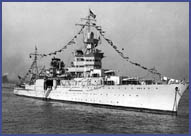|
The Day the Sharks Came  Official U.S. Navy photograph. Seaman Third Class Glenn Morgan was a bugle-master on board the pre-war heavy cruiser USS Indianapolis (CA 35). It was his job to be on the fantail (rear) of the ship every morning as the colors were raised and sound taps at night to mark the end of the day. The problem with being on board a warship at sea is the day never really ends. There are always people standing watch, twenty four hours a day, seven days a week. Morgan slept in an armored compartment just below the bridge. The bridge is where they control the ship's movement. If the bridge comes under attack the men move one deck below and continue driving the ship during combat. At midnight Morgan was sleeping in this room of reinforced steel that he was charged with maintaining daily.Lindsey Wilcox was a Seaman Second Class working on the ship's boiler system way down in the lower decks, but at midnight he had just gotten off his four hour watch. His plan was to crawl into his rack (bed) and get some sleep. He was lucky, he was up, awake and still in his uniform. Seaman First Class L.D. Cox was on the bridge, standing the midnight to four watch, driving his ship through the south Pacific seas. His friend Glenn Morgan was just below him sound asleep. A few minutes after midnight two loud explosions rocked the Indianapolis and ten minutes later the ship sank. Because the above three men where either awake or very close to the open upper decks of the ship they were able to swim away in those short ten minutes before their ship slipped under the waves. The almost instant sinking of their ship was the start of five days of terror and a lifetime of painful memories. Many of the sad memories were about the way the crew and ship's captain were treated after the sinking. If you have watched the movie "Jaws" there was a scene where the old shark hunting sea captain (Robert Shaw) and the young marine biologist were comparing their scares. The captain told how he had been on board the USS Indianapolis when it was sunk in shark infested waters. How over 900 men went into the ocean after the attack by a Japanese submarine and only 317 survived because the sharks circled the sailors and killed so many men. Shaw's Hollywood character was not real but the USS Indianapolis was and the death of so many men by shark attack is true naval history. The three surviving seaman I met at the Iwo Jima Veterans reunion in Wichita Falls, Texas were well into their eighties and glad to have been allowed to live every one of those days since the USS Indianapolis went down. They came home and got on with their civilian lives. All three men told me that their families did not know about the sinking or the shark attacks until the movie "Jaws" came out. The USS Indianapolis was the last US Navy surface ship to be sunk during WW II. It had just completed a top secret mission to deliver the world's first atomic bomb to Tinian Island in the Pacific on 26 July 1945. The ship was then dispatched, without escort, to join a battle group in Leyte Gulf preparing for the invasion of Japan. En route they were torpedoed and, because their recent secret mission had taken the Indianapolis "off the books," not missed by the Navy for five long days. In fact it was not until an airplane spotted men in the water and sounded the alarm to the US Pacific fleet that the Navy even knew the USS Indianapolis was lost. Captain McVay, the ship's commander, was court marshaled by the Navy. It was done so fast that McVay was not allowed time enough to prepare his defense. However, the Navy found the Japanese submarine commander, got him to the trial, and had the "enemy" testify against their own naval officer. Secretary of the Navy Forestall was supposed to be in the business of ships, but in the case of Captain McVay, the good Secretary was in the "rail-roading" business. The men of the USS Indianapolis were made to feel that they were at fault for the worst maritime disaster in US Naval history. The senior powers-to-be forgot the enemy in that equation. I would suggest that the ship's crew and captain did not know who their real enemy was. Everyone in the Navy then and now knows that Captain McVay was not at fault, but in 1968 he took his own life. Family members of dead crewmen had continually hounded McVay. The Navy said he was criminally at fault for "hazarding his ship by failing to zigzag," (even though the Japanese submarine commander honorably testified that zigzagging would have made no difference) and the grieving families needed someone to blame and hate. Not all is fair in love or war. Editor's Note: "In July of 2001 the Navy Department announced that Captain McVay's record has been amended to exonerate him for the loss of the Indianapolis and the lives of those who perished as a result of her sinking. The action was taken by Secretary of the Navy Gordon R. England." |